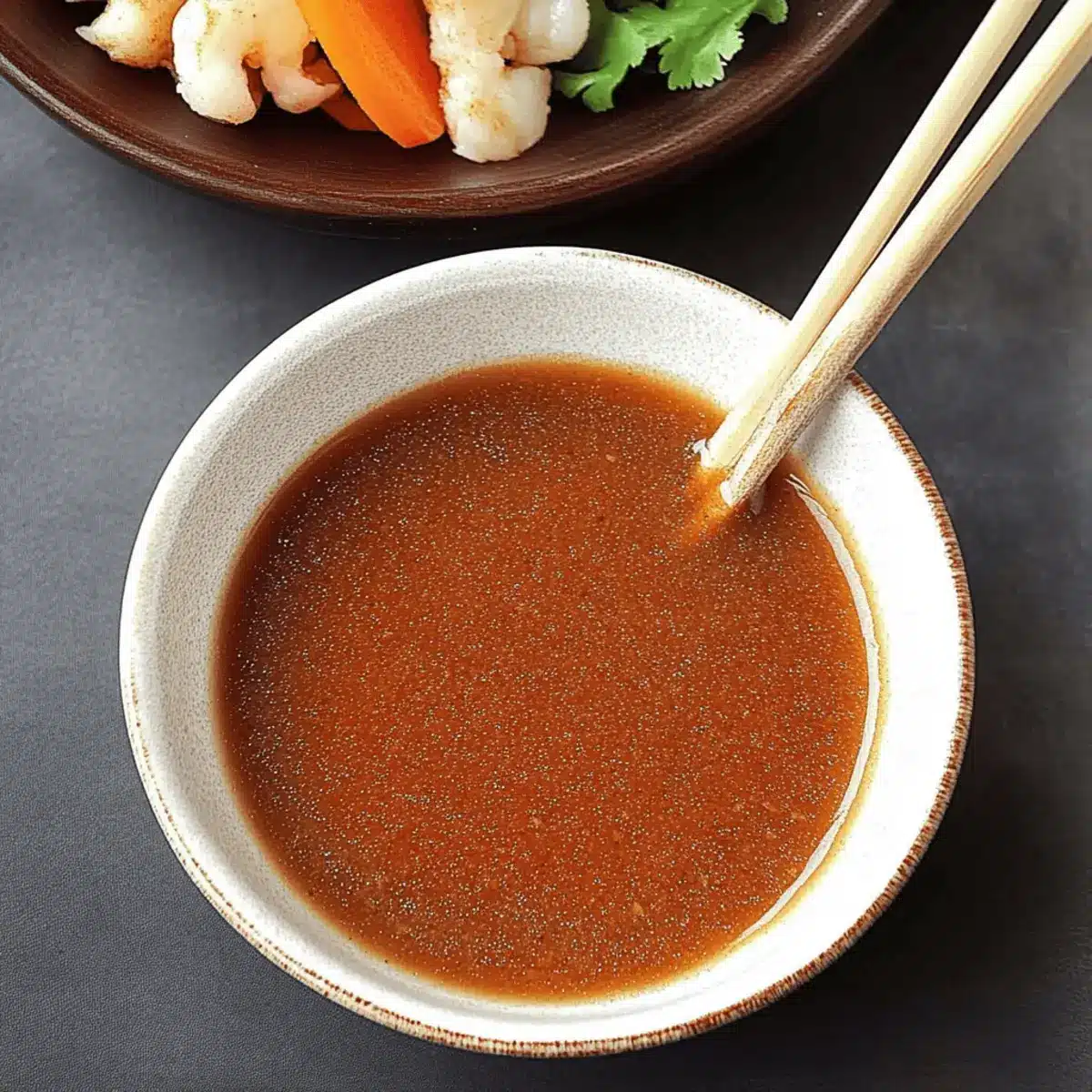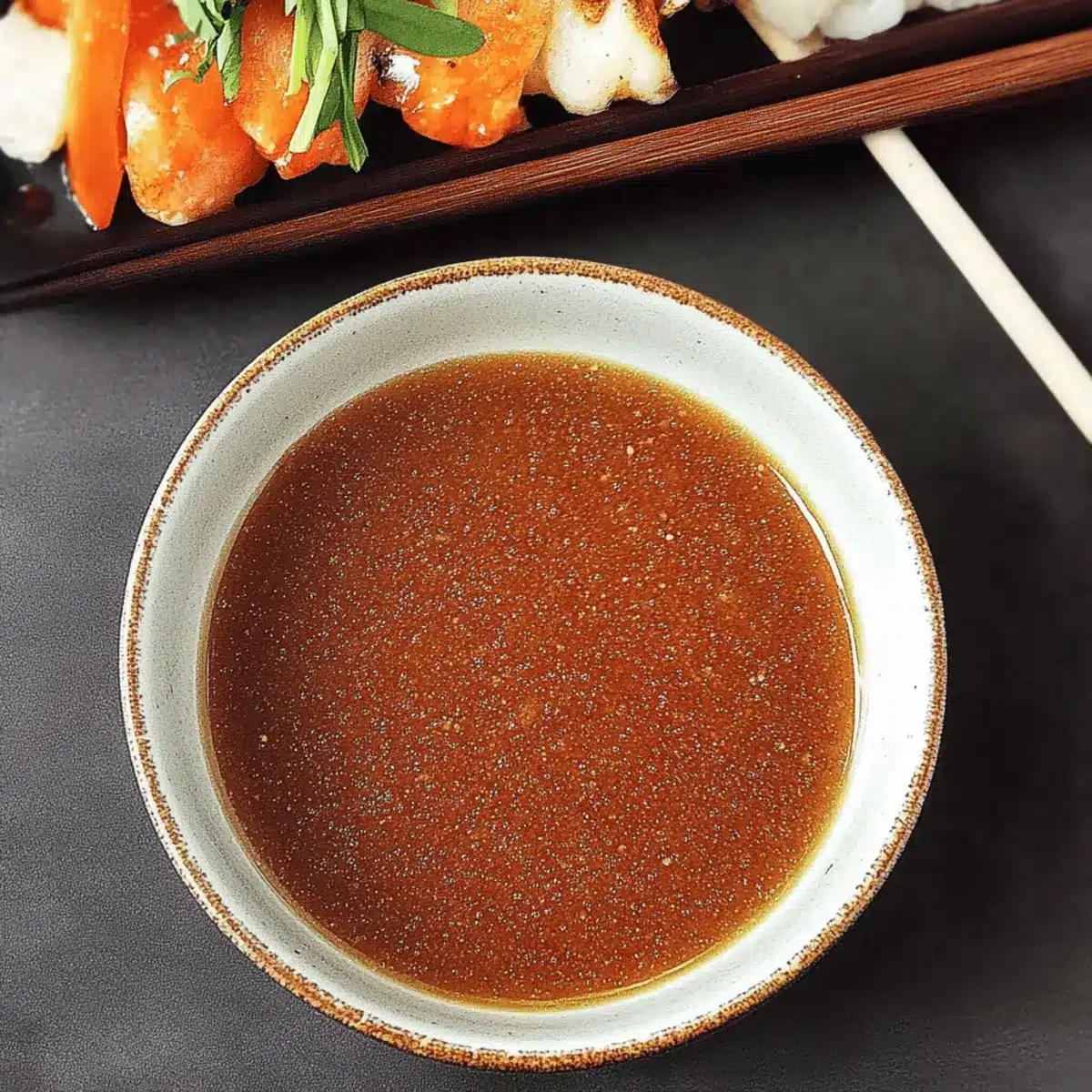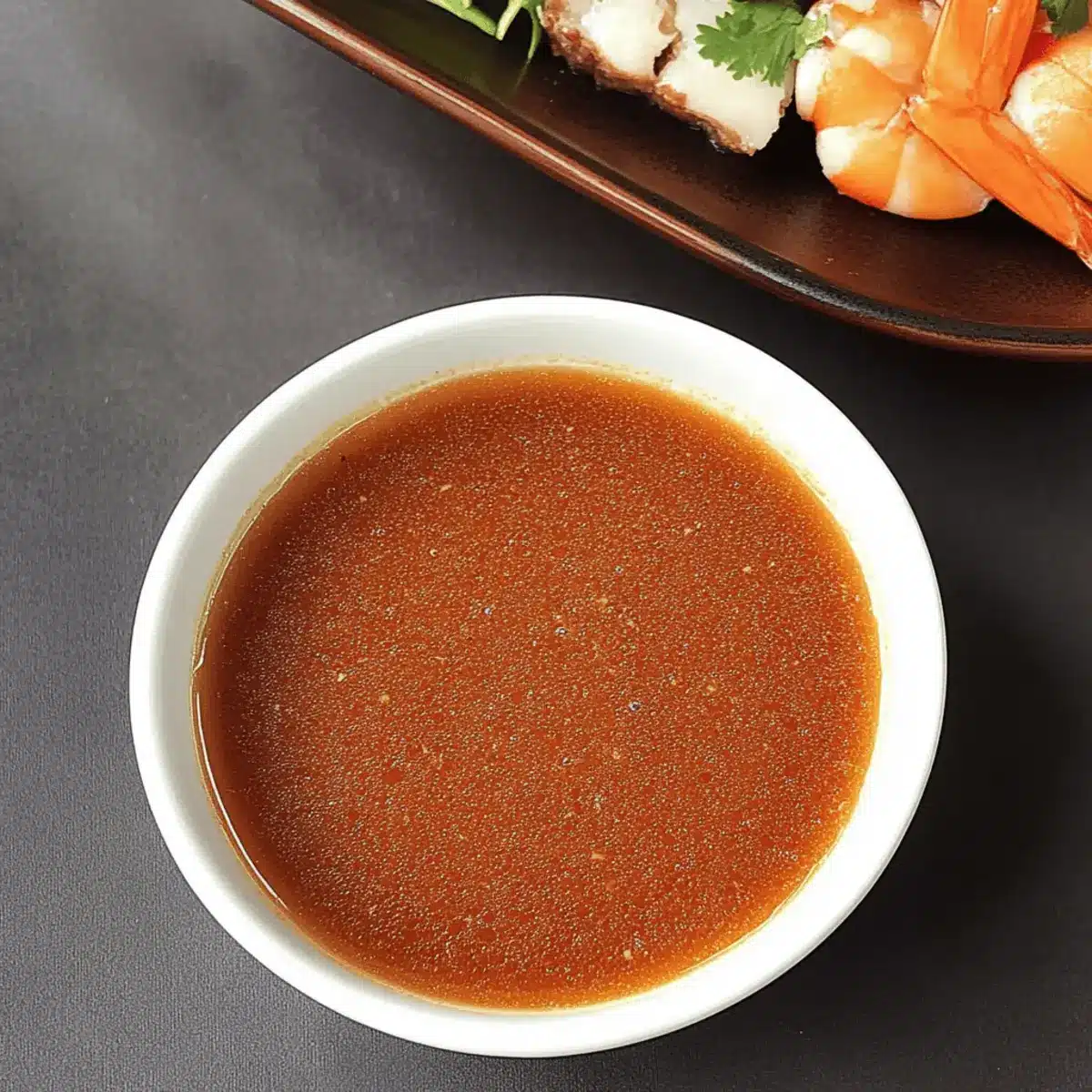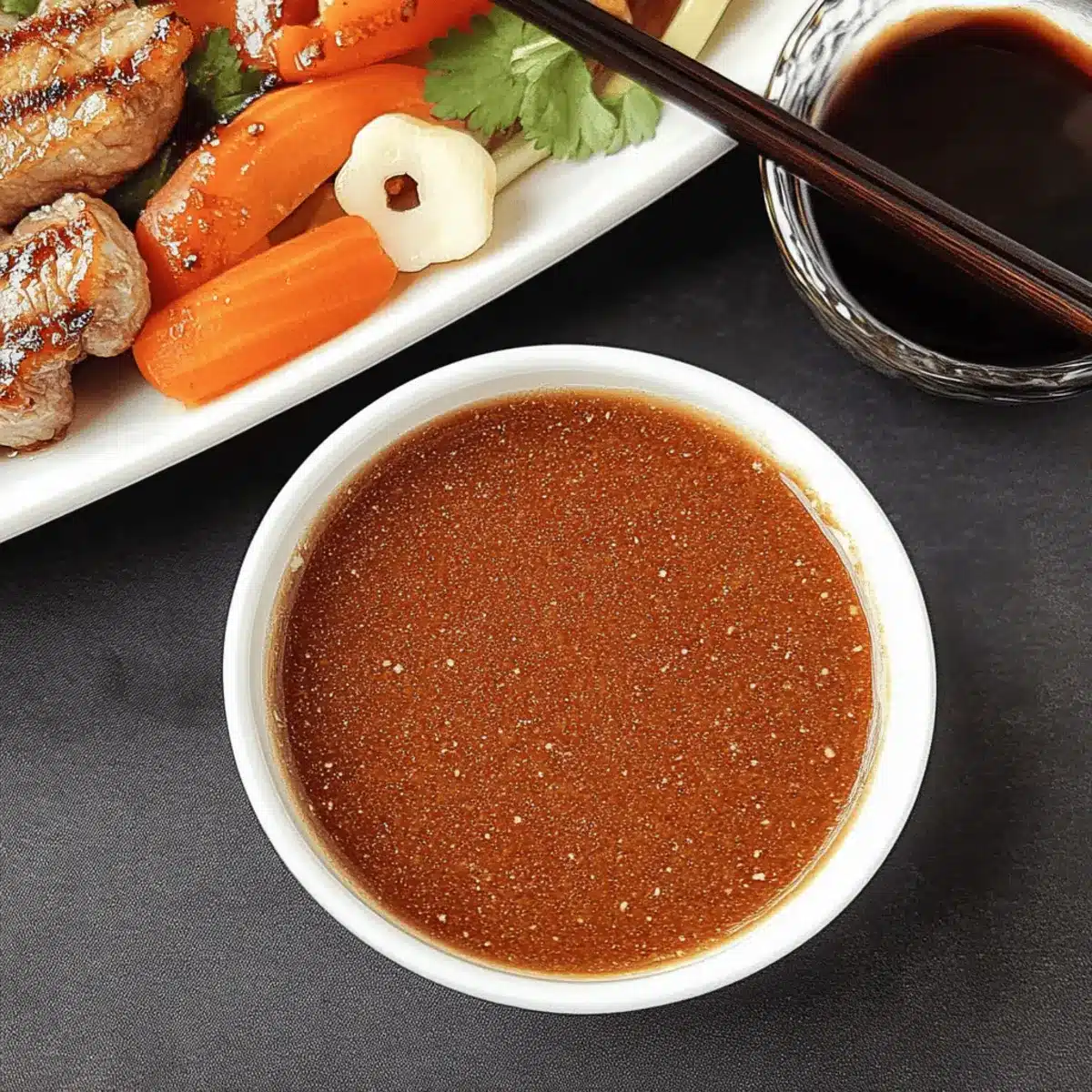As I stood in my kitchen, the aroma of ginger wafted through the air, instantly transporting me to the vibrant atmosphere of a Japanese steakhouse. Today, I’m thrilled to share my Quick & Easy Japanese Steakhouse Ginger Sauce, a recipe that transforms any meal into an exotic culinary experience in under 5 minutes! With just five simple ingredients, this delightful sauce offers the perfect balance of zesty brightness and smooth richness—ideal for dipping grilled steak, chicken, or fresh veggies. Plus, its quick prep makes it a fantastic go-to for those busy weeknights when fast food calls, but homemade goodness beckons. So, what will you create with this versatile sauce that promises to elevate your dinner routine?

Why Is This Sauce So Special?
Bursting with Flavor: This Japanese Steakhouse Ginger Sauce packs a punch of fresh ginger, balanced perfectly with zesty lemon and savory soy sauce.
Quick Preparation: In just 5 minutes, you can whip up this versatile sauce, making it a lifesaver for busy evenings.
Superb Versatility: Ideal for dipping grilled meats, seafood, or drizzling over fried rice, it complements a wide variety of dishes. Check out how great it pairs with Sausage Sweet Sauce or Chicken White Sauce!
Fresh Ingredients: With only five simple components, crafting this vibrant sauce means saying goodbye to store-bought options filled with preservatives.
Attractive Nutrition: Each serving contains just around 16 calories, so you can enjoy it guilt-free!
This sauce isn’t just a recipe; it’s an experience waiting to elevate your meals tonight!
Japanese Steakhouse Ginger Sauce Ingredients
For the Sauce
• Minced Ginger or Ginger Paste – Fresh ginger is recommended for authentic flavor, but ginger paste works well too.
• Diced Onion – Choose to use ½-¾ cup depending on your taste preference for sweetness.
• Soy Sauce – This ingredient adds umami and saltiness, key for the Japanese Steakhouse Ginger Sauce flavor.
• Lemon Juice – A splash brings brightness and balances the overall taste of the sauce.
• White Vinegar – Essential for acidity, it enhances flavor and helps preserve your sauce.
Step‑by‑Step Instructions for Japanese Steakhouse Ginger Sauce
Step 1: Chop the Onion
Begin by finely dicing ½ to ¾ cup of onion. This ensures that the onion blends smoothly into the sauce, maintaining a mellow flavor without overpowering the ginger. Aim for small, uniform pieces to allow even blending, and set them aside once chopped. A sharp knife makes the task easier and safer!
Step 2: Prepare the Ginger
If you’re using fresh ginger, peel a piece and mince it until you have a generous amount. Fresh ginger is key for an authentic taste in your Japanese Steakhouse Ginger Sauce. If you are using ginger paste, measure out an equivalent amount. It should look aromatic and fragrant, reflecting the vibrant flavors that’s about to come.
Step 3: Combine Ingredients
In a food processor, add the minced ginger, diced onion, soy sauce, fresh lemon juice, and white vinegar. Make sure each ingredient is evenly distributed in the processor bowl. Close the lid securely before blending, as this will create a rich, cohesive flavor while keeping your kitchen mess-free.
Step 4: Blend to Perfection
Pulse the mixture for about 30-45 seconds until it reaches a smooth consistency. The color will lighten slightly as air incorporates into the Japanese Steakhouse Ginger Sauce, providing the right texture and blending the bold flavors. Stop occasionally to scrape down the sides for uniformity.
Step 5: Taste and Adjust
Once blended, taste the sauce to ensure the balance of flavors is to your liking. If desired, add an extra splash of lemon juice or vinegar for brightness, or more soy sauce for saltiness. Blend again briefly, just 10-15 seconds, to combine any adjustments seamlessly.
Step 6: Serve or Store
Transfer the sauce into a small serving bowl. This zesty Japanese Steakhouse Ginger Sauce is perfect as a dip for grilled meats, seafood, or vegetables. If not serving immediately, store it in an airtight container in the refrigerator for up to two weeks, allowing the flavors to meld beautifully.

Make Ahead Options
These Quick & Easy Japanese Steakhouse Ginger Sauce preparations are perfect for busy home cooks looking to save time during the week! You can chop the onion and mince the ginger up to 24 hours in advance; simply store them in airtight containers in the refrigerator to keep them fresh. For the sauce, blend all the ingredients and refrigerate it for up to one week—the flavors will develop beautifully! When you’re ready to enjoy, just give it a quick stir before serving. This makes it a fantastic option for meal prep, allowing you to have restaurant-quality ginger sauce at your fingertips, ready to elevate any dish without the hassle on busy nights!
Expert Tips for Japanese Steakhouse Ginger Sauce
-
Use Fresh Ginger: Opt for fresh ginger over ground ginger to achieve a vibrant, authentic flavor that truly elevates your Japanese Steakhouse Ginger Sauce.
-
Blending Technique: Ensure your food processor is powerful enough to create a silky texture; this helps the sauce blend evenly without lumps.
-
Adjust to Taste: Don’t forget to taste as you blend! A splash more lemon juice or soy sauce can enhance the flavor balance of your sauce.
-
Storage Know-How: Keep the sauce in an airtight container in the fridge for up to 1-2 weeks. It only gets better with time!
-
Vary Your Ingredients: For a gluten-free option, substitute soy sauce with tamari. Experiment to find your favorite variation!
Storage Tips for Japanese Steakhouse Ginger Sauce
Fridge: Store your Japanese Steakhouse Ginger Sauce in an airtight container for up to 1-2 weeks. This allows the flavors to develop and meld beautifully over time.
Freezer: For longer storage, freeze the sauce in ice cube trays for up to 3 months. Once frozen, transfer the cubes to a zip-top bag for easy access to single servings.
Thawing: To use, simply remove a cube or two from the freezer and let them thaw in the refrigerator or a bowl of warm water.
Reheating: If you prefer warm sauce, heat it gently in a small saucepan over low heat, stirring occasionally until it reaches your desired temperature.
Japanese Steakhouse Ginger Sauce Variations
Feel free to get creative with your Japanese Steakhouse Ginger Sauce to suit your taste buds or dietary needs!
-
Gluten-Free: Replace soy sauce with tamari for a gluten-free option without sacrificing flavor. It’s a simple swap that makes a big difference for gluten-sensitive friends!
-
Sweet Twist: Add a teaspoon of honey or maple syrup for a sweeter version. This small addition not only brings a delightful contrast but also elevates the overall flavor profile.
-
Heat Boost: Stir in a pinch of red pepper flakes or a splash of sriracha for a spicy kick that will make your taste buds dance. The heat harmonizes beautifully with the sauce’s underlying sweetness.
-
Herb Infusion: Incorporate fresh herbs like cilantro or parsley into the blend for an added layer of freshness. It not only brightens the presentation but also enriches the flavor, making it even more aromatic.
-
Sesame Flavor: Drizzle in a bit of sesame oil to give your ginger sauce a nutty depth. This variation pairs especially well with grilled meats, creating a delightful contrast to the ginger.
-
Fruit Fusion: Experiment by adding pureed fruits such as pineapple or mango for a tropical twist. This makes the sauce perfect for summer cookouts or unique marinades!
-
Soy-Free Alternative: For a soy-free sauce, try coconut aminos as a substitute for soy sauce. It’s less salty and imparts a subtle sweetness, not to mention it’s a great option for those avoiding soy.
-
Thicker Texture: If you prefer a thicker sauce, you can add a small amount of cornstarch mixed with water, heating it gently to thicken it. This is great if you’re using it as a glaze or dip!
With these tasty variations, you can customize your ginger sauce to fit any meal, making it a beloved staple in your kitchen just like my cherished Choy Garlic Ginger dish. Enjoy experimenting!
What to Serve with Quick & Easy Japanese Steakhouse Ginger Sauce
This vibrant sauce is a delightful addition to any meal, enhancing flavors and bringing your dishes to life.
- Grilled Steak: The bold ginger flavor complements the smoky char of grilled steak, creating a delicious harmony that’s irresistible.
- Seafood Skewers: Drizzle this sauce over shrimp or scallops for a tangy brightness that enhances the natural sweetness of the seafood.
- Fresh Veggies: Crisp vegetables like bell peppers and cucumbers pair beautifully, adding a refreshing crunch to your dipping experience. Enjoy the contrast of the cool veggies with the warm sauce!
- Fried Rice: A drizzle over fried rice elevates each grain, making every bite a flavorful adventure as the ginger’s zest meets savory soy.
- Roasted Chicken: The sauce’s tang balances the richness of roasted chicken, giving your meal a zesty lift that’s simply unforgettable.
- Sushi Rolls: Use this ginger sauce as a dip for sushi rolls for an extra layer of flavor that transforms your sushi experience into something extraordinary.
- Soba Noodles: Toss soba noodles with this sauce for a quick and satisfying dish that brings depth and excitement to your weeknight meals.
- Chilled Tofu: Pair with chilled tofu for a light and refreshing option, where the ginger adds a vibrant kick to the milder flavors of the tofu.
- Sparkling Water: A sparkling water infused with lemon complements the meal perfectly, refreshing your palate between bites with its bubbly zest.
- Green Tea Ice Cream: For dessert, enjoy the contrast by serving green tea ice cream, the creamy matcha balancing the zing of your ginger sauce—an unexpected yet delightful finish!

Japanese Steakhouse Ginger Sauce Recipe FAQs
What type of ginger should I use for the sauce?
Absolutely! I recommend using fresh minced ginger over ground ginger for a more potent and authentic flavor. Fresh ginger gives the sauce its distinct pungency and richness, essential for capturing that beloved Japanese steakhouse taste.
How can I store the ginger sauce, and for how long?
You can store your Japanese Steakhouse Ginger Sauce in an airtight container in the refrigerator for up to 1-2 weeks. This allows the flavors to develop further as they meld together. The more the merrier when it comes to flavor!
Can I freeze the sauce?
Yes! To freeze your ginger sauce, pour it into an ice cube tray and freeze until solid, which typically takes about 2-3 hours. Once frozen, transfer the cubes into a zip-top freezer bag and store them for up to 3 months. When you’re ready to enjoy, just pop a cube or two out and let them thaw in the refrigerator or warm water.
What should I do if my sauce is too sweet or salty?
If you find your sauce is leaning too heavily on sweetness or saltiness, there’s an easy fix! To balance the flavors, add a splash more lemon juice or vinegar to elevate acidity and cut through the sweetness. Blend again for just 10-15 seconds to incorporate, and taste again until satisfied.
Is this sauce suitable for those with dietary restrictions, such as gluten intolerance?
Absolutely! For those with gluten sensitivities, you can easily make a gluten-free version of this sauce by substituting traditional soy sauce with tamari. It provides a similar umami flavor without gluten, ensuring everyone can enjoy this zesty sauce!
How do I know if my onion is fresh and ready to use?
When selecting an onion, look for smooth, papery skin free of dark spots or soft spots. Fresh onions should feel firm to the touch and have a pleasant aroma. If you notice any dark spots all over or a strong, unpleasant smell, it’s best to choose another onion.

Zesty Japanese Steakhouse Ginger Sauce in Just 5 Minutes
Ingredients
Equipment
Method
- Begin by finely dicing ½ to ¾ cup of onion. Set them aside once chopped.
- Peel and mince a piece of fresh ginger or measure out ginger paste.
- In a food processor, add the minced ginger, diced onion, soy sauce, lemon juice, and white vinegar.
- Pulse the mixture for about 30-45 seconds until smooth.
- Taste and adjust with more lemon juice, vinegar, or soy sauce if needed.
- Transfer the sauce into a small serving bowl or store it in an airtight container.

Leave a Reply